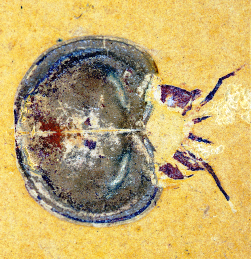
The 525 million year old Chengjiang fauna, from Yunnan in China, are preserved in pyrite, which shows up their remarkable level of detail against pale mudstone. Ten million years older than the famous Burgess Shale, and arguably even more beautiful, these fossils are little known. This is their first major exhibition outside China, yet you could be forgiven for missing them altogether – they will be on show for six months, returning to China in mid November.
The Chengjiang fossils may not be as immediately impressive as the museum’s dinosaur skeletons or stuffed dodos, but this astonishing exhibition is full of things not normally associated with fossils – colour, movement, light. Among the many specimens on show are primitive fish, some of which represent the oldest known vertebrates in the world.
“To me, these fossils are equivalent in terms of wonder to seeing the Terracotta Warriors for the first time”, says curator Derek Siveter, who showed me around the exhibition. “I don’t know exactly what the importance of the Terracotta Warriors is to our knowledge of history, but these fossils are unbelievably important to our knowledge of the history of life”.
Discovered in 1984 by Chinese palaeontologist Hou Xianguang, the fauna bears witness to that great benchmark in the history of life, the Cambrian explosion, when many of the major groups which have gone on to dominate global marine and terrestrial biota first emerged. “The preservation is just spectacular” says Siveter.
“Many of them are entirely soft-bodied – they have no right to be preserved! Here you can see worms, all curled up as though they died yesterday, the various segments clearly indicated, and the remains of the gut still intact.”
“And we have sea gooseberries, which are unbelievably sparse in the fossil record – they’re almost like a little lump of jelly. Some five genera have been described from Chengjiang, and they represent the earliest example of this particular group in the fossil record. Here we see an arthropod just nonchalantly flicking its tail, as it would have done in life – it looks like it’s doing a little dance!”
The fossils were sent to the museum in February after months of negotiation and uncertainty. “I’ve learnt to know that you have to actually see the material to believe it” says Siveter. “We were never quite sure whether the Chinese would send it. Once they did, we had very little time to see what they’d sent us and build an exhibition around it”.
As well as fossils, the museum features some live exhibits. Visitors can watch bees going about their business in a hive and swifts nesting in the museum tower via a webcam. It has also developed a number of ‘touchable’ exhibits, from foxes (stuffed) to meteorites (ebay) which visitors are invited to ‘please touch’.
Despite these recent innovations, the museum remains staunchly traditional in its appearance. What at first might seem like a regressive move has resulted in a beautiful building that reflects its past at no expense to present day visitors, and makes a refreshing change to the overwhelmingly modern design of many of its counterparts.